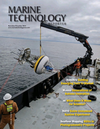
Page 37: of Marine Technology Magazine (November 2023)
Read this page in Pdf, Flash or Html5 edition of November 2023 Marine Technology Magazine
Where Does Tiamat Work?
Jake Storey, Executive Director of Haven Dredging, admits that the Tiamat dredging technology is not a ‘silver bullet’ solution. “We see Tiamat as complimenting existing forms of dredging; it will perform better in certain locations than a water injector; it will be cheaper, and as effective or as productive as a trailer in other locations.” He said Tiamat “puts energy into the system, it pumps [material] up into the water column.
If you want to move sand and gravel, you won’t move it a great deal of distance with a Tiamat, unless you’ve got huge amounts of tidal ? ow and super strong currents. However, if you only want to move it a couple of hundred meters then the Tiamat may work, if you want to move it out of your harbor, then the Tiamat won’t be your solution.” In the Harwich Haven Authority, the sediment is predominantly clay silt with a bit of sand, with a tidal range of about two to three meters and currents just under one knot. “We have parts of the harbor where the Tiamat reduces the strength of the sediment, but leaves it behind because we have eddies.
In other parts of the harbor, because of the way the currents move and where the tide goes, it just takes it out of the harbor completely. If you want to move the sediment long distances, then you need a decent current tide and silt. If it’s highly compacted sediment, you can’t break the laws of physics. The Tiamat will have an impact on it, but you most probably need a cutter or a backhoe or a trailer.” of the capacity and resource constraints that exist in the dredg- ing market, and lowers fuel consumption compared to tradi- tional methods. It also eliminates the travel back and forth to disposal sites, which comes with a de? nitive and measurable
GHG emission impact.
“Also, it works best where you’re going from shallower wa- ter to deeper water,” said Storey, relying on gravity and the slope to help do the job.
With positive environmental impact results, the icing on the cake is the ? nancial savings, too. “What it means going for- ward is that we won’t need to have six trailer campaigns a year,” said Storey. “We’ll have two or three, and that’s where the cost savings and the greenhouse gas emissions savings come. So for us, and it is site speci? c, on a Tiamat campaign of 30 days as compared to a trailer campaign of 10 or 12 days, our greenhouse gas emissions are 65% less. And likewise, on cost wise for us, maintenance dredging for a trailer campaign would be between £1.2 million to £1.5 million. And a Tia- mat campaign is roughly between £400,000 and £500,000. So next year, we anticipate to save about £2 million or £3 million pounds just in our harbor. And for us, that’s about 50% of the total cost of maintenance dredging that we’re saving.”
While Storey is obviously bullish on the Tiamet technology, he points out that the tech is not meant for use on any and every site, as distance to dredge disposal area, consistency of dredge material and the nature of the tidal ? ow and water col- umn all come into play. “If we would have had a disposal site one mile offshore, I don’t think we would’ve invented the Tia- mat because we didn’t have the business need from the green- house gas emissions and a cost perspective. For us, it is driven by the location of our disposal site, and the economics of it.” www.marinetechnologynews.com 37
MTR #8 (34-47).indd 37 11/28/2023 1:36:16 PM

 36
36

 38
38
